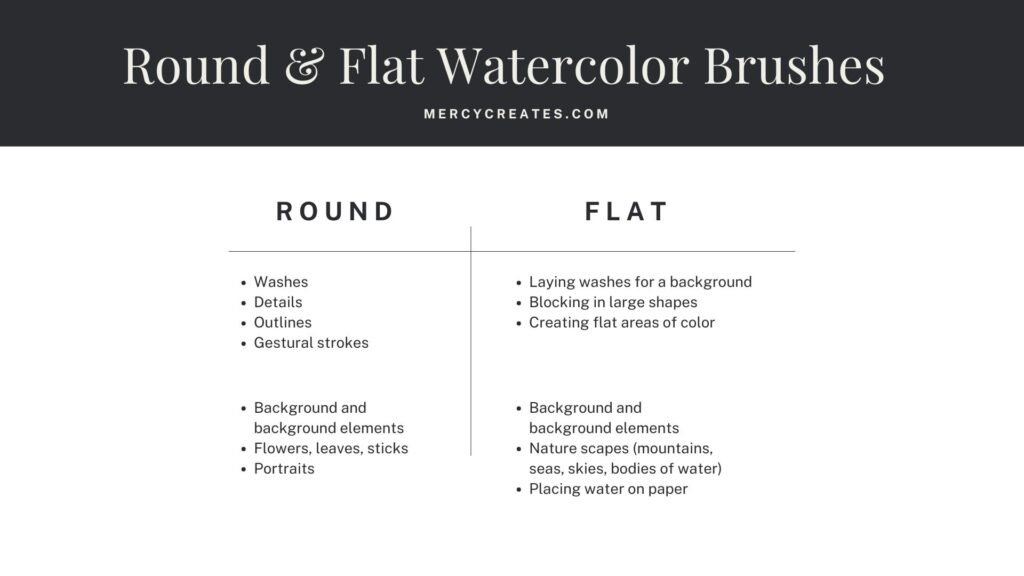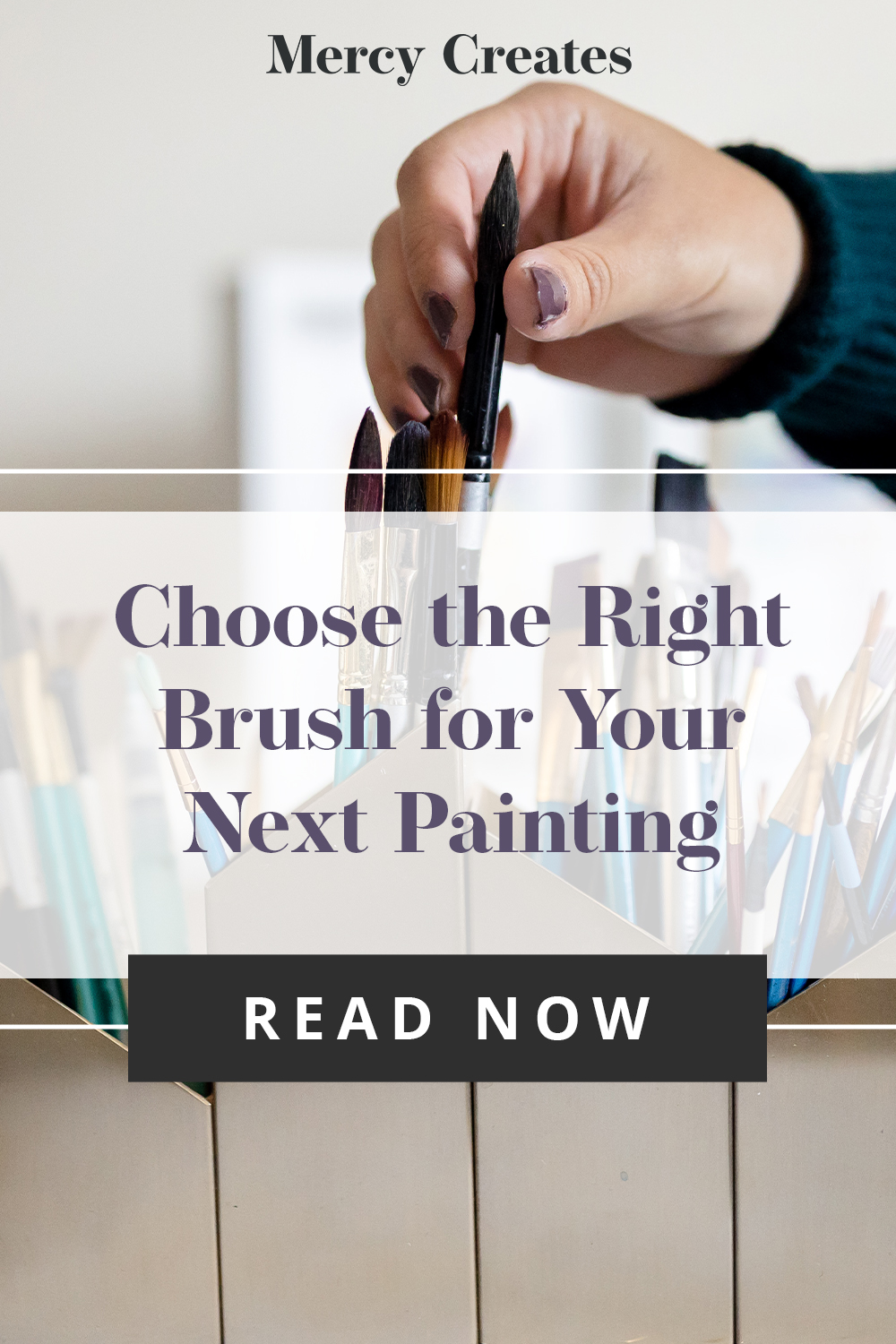If you’ve ever felt frustrated when your watercolor paintings don’t quite match what you had in mind, you’re not alone. One of the biggest obstacles standing between you and that dream masterpiece might be something as simple as your choice of brush.

Yup. That little and sometimes inexpensive tool can make or break your painting.
“Aren’t all brushes the same? Do they really matter that much?”
Friend, they absolutely do. Your hairstylist isn’t trimming your hair with safety scissors—in fact, they have several different types of scissors based on hair texture and the cut they’re trying to achieve.
This post is all about why understanding your brushes could be the game-changer your creativity is longing for.
[If you want to skip the blog, photos, and videos and want the answers yesterday… join Watercolor Foundations! This digital course eliminates the guesswork of watercolor painting. It’s a deep dive into the equipment, tools, techniques, and process—because I believe that if you understand why and how, you’ll throw away less paper and start framing your own work in your house. Join Watercolor Foundations here >> ]
Aisles of Brushes, Aisles of Option… But Which Brush Is Right?
Have you ever stood in front of a display of brushes at the art store, overwhelmed by all the shapes and sizes? Round, flat, fan, filbert, mop—so many choices! They’re all sized differently… and then some stores even categorize them by bristle material? It’s options on options, and even as career artist, I often feel overwhelmed with which brush to pick up and purchase.
It’s hard because even though you purchase the “right” set of brushes… how they behave on the watercolor paper can add another layer of complexity.
You try one, and the strokes look too heavy; you try another, and the paint doesn’t flow the way you want it to. Some are holding a ton of water, and some brushes hold barely any paint. It’s enough to make anyone second-guess their artistic abilities.
Like I said: I’ve been there, too, struggling with messy, muddy paintings, wondering why they didn’t resemble the beautiful images in my head. But, friend—the problem wasn’t me (at least on some days, it wasn’t me 😏).
If I only took the time to understand how the tools worked… the painting may have looked closer to what I was imagining.
Know the Differences: Round and Flat Watercolor Brushes
Let me paint (ha ha 🥁) the backdrop for you:
A cozy day at home in your oversized sherpa jacket, warm coffee (or tea) to the side, and warm sunlight is coming through the window. It’s the perfect natural light for your project. The table is set with paper, the “Ocean Storm” color palette, and a playlist inspired by the Psalms has you mentally ready to tackle this painting.
You pick up a brush and start to add water to the paper, but the colors run wild, the lines blur, and the detail you hoped for is nowhere to be seen.
Been there, done that, threw away the paper, and left discouraged.
The truth, Friend? The brush you use influences how your paint behaves on the page.
For instance, a round brush is fantastic for details and thin lines, but if you want broad, sweeping strokes, a flat brush would be more appropriate. Each brush has its own personality, and knowing how to “listen” to it can be the key to unlocking your creativity.
Here are two of the most popular watercolor brushes:
- The Round Brush: The multitasker of the brush world. With its fine point, it’s perfect for details like flower petals or calligraphy. Add more pressure, and you can create thicker, more expressive strokes.
- The Flat Brush: When you need strong, defined edges, the flat brush is your go-to. Great for bold backgrounds or crisp lines in landscapes. Plus, it holds more water, giving you smooth, even washes.

If I’m setting out to paint a floral wreath… I CANNOT pick up a flat brush. The petals would look boxy and chunky—not at all the feminine and delicate petals that I’m envisioning.
And if I want to create the illusion of morning fog over the Blue Ridge Mountains… I absolutely cannot achieve that as well with a round brush than if I used a flat brush.
Remember—everyone has different tools that achieve different purposes:
- Craftsmen use different wrenches and sockets for putting together building frames.
- Seamstresses use different needles depending on the material of the cloth—linen, denim, or satin.
- Chefs use different measuring cups depending on the recipe and amount of spice.
The same is true of watercolor painting: different tools have different results. When we choose the right tool, our paintings go from good to great.
You CAN Choose the Right Brush Everytime
This blog post gives a brief overview of the two most common watercolor brushes, but there is so much more to discover, and here’s the best part: you don’t have to figure it all out on your own. Imagine how much easier painting would be if someone could guide you through each brushstroke, showing you exactly when and how to use each tool to bring your vision to life.
That’s why I created Watercolor Foundations. This course sharpens your skills and helps you enjoy this medium with over-the-shoulder videos, a workbook, step-by-step projects, downloadable color palettes, and more! Think of this blog post on round vs. flat brushes as that twice-baked potato, cheese, and bacon appetizer before getting to your grilled salmon with green beans and rice pilaf. Join Watercolor Foundations here.
In Watercolor Foundations, you’ll not only learn the fundamentals of how to use your brushes effectively, but you’ll also uncover how to pick the perfect brush for every painting. I’ll share my personal tips on:
- Choosing the right brush for the right job.
- Mastering different brush techniques, from delicate details to broad washes.
- Understanding how to maintain and care for your brushes, so they last longer and perform better.
Imagine the confidence you’ll feel when you sit down to paint, knowing you have the right tools and skills at your fingertips. Your art will transform—not by accident, but by design.
Don’t waste another sheet of paper wondering where you went wrong.
Join Watercolor Foundations today, and take the first step toward mastering the art of watercolor brushes (and so much more).
You’ve got the talent—you just need the tools. Let’s paint something beautiful together.

Leave a Comment +